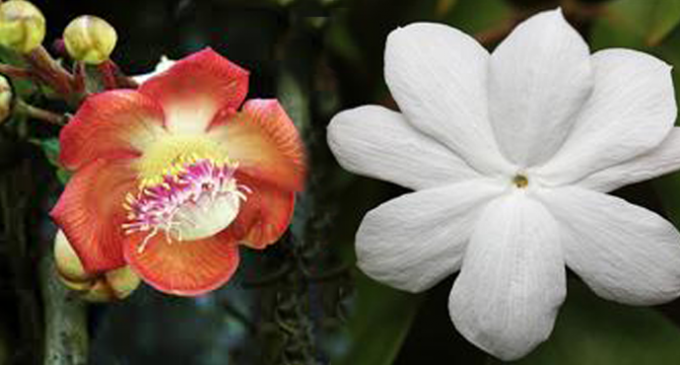Flora in Myanmar Culture: Ingyin and Myat Lay in Waso (JULY)

Waso is the fourth month of Myanmar Lunar calendar corresponding to July. Waso is the begin-ning of Myanmar monsoon and it is one of the holy months for the Buddhists who celebrate the monthly festival of ordination. Among a variety of wild flowers that come out in profusion, Ingyin and Myat Lay are tradi-tionally designated flowers of this month.
Botanically Ingyin is Sal tree, tall indigenous hardwood tree bearing sprays of fragrant red flowers. Botanically termed Pentacme Suavis. Some dictionaries give scientific name “Shorea robusta for Sal tree.
Myat Lay is a creeper plant which is a bush type up to five feet high. It is a species of jasmine star ipomea. Myat Lay Ni (red jasmine) is Ipomea quamochit and Myat Lay Hpyu is Ipomea coccinea in scientific names.
Both Ingyin and Myat Lay are medicinial. Firstly their blooms, fresh or dry, are used in ointment for their fragrance as well as in aromatic therapy. Fresh blooms are much sought after by Myanmar fairer gender who like to deck their different styles of choiffeurs.
Ingyin tree is a Bodhi Tree because Ves-sabhu Buddha became enlightened under its shade. So Ingyin Tree is worshipped as Pari-bawgau zedi, representing the Buddha.
Myat Lay flowers are offered to the Bud-dha shrines. In the days of Myanmar Kings Myat Lay and jasmine flowers were presented to the court. Dry Myat Lay blooms are com-pounded with hair tonic oil. In Myanmar literature the word “Lay tayar si” means “Ointment or hair tonic oil perfumed with hundheds of Myat Lay flower”.
Ingyin tree is very much associated with Buddha’s history. To begin with, while Gotama Buddha was white elephant King “Saddan” in one of his previous existences he had two queens–Maha Subbaddha and Cula Subbaddtha on his right and left side respectively. His name Saddan means six tusker or six colours rays emitting from his tusks. The three were happy in the Himalayan forests. One day at a big lake full of lotus flowers under the shades of Ingyin trees the three were rollicking. It just happened that the Ingyin flowers given to Cula Subbhaddha by King Saddan had some red ants, whereas those given to Maha Suaddha had no such insects. Cula Subbaddha felt insulted and she kept a grudge against King Saddan. Next occasion, King Saddan gave lotus flowers to Maha Subbaddha first and to Cula Subbaddha later. Again Cula Subbaddha felt annoyed. She vowed to take vengeance upon King Saddan.
One day when a Saint monk appeared Cula Subbaddha offered lotus flowers and seeds to the Saint monk praying that she wished to wear earrings made out of King Saddan’s tusk. The Saint monk just said “Amen, So be it”. When Cula Subbaddha died, she was reborn human and became queen of King Brahmaddatha. She told the King that she had a strong desire for wearing earrings made out of the tusks of King Saddan living in the Himaluyan Forests. The King sent his best elephant hunter Sonutara to bring Saddan’s tusk to court.
After many adventures, and many tactics in capturing Saddan, the hunter shot King Saddan. When Saddan got hold of the hunter, the hunter pleaded he was not guilty. It was the queen who wanted his tusk and the King ordered him to get the tusks. When Saddan knew that it was his previous queen who took vengeance upon him, Suddan cut his tusk and offered it to the hunter to take to the queen. At the court the hunter explained all that happened and presented the tusk. The queen heard that king Suddan willingly cut his trusk for her and now he was dead. Watching the tusk, she repented very much and extreme remorse overcame her, and she died of broken heart. So Ingyin tree had a tragic story in Buddha Jataka.
Next was the birth story of Prince Siddhatha. Pregnant Maha Maya chief queen of King Sudhodana of Kapilavathu Kingdom was on her long land journey to visit her brother’s Kingdom. On the way she gave brith to a boy child Prince Siddhatha. Hurriedly preparations were made for her confinement in the forests of Ingyin trees. Tired and weak Maha Maya held a branch of Ingyin Tree in full labour and delivered her boy son. So Ingyin Tree was auspicious and sacred.
The first Sermon “Dhammacakka Sutta” was given by Lord Gotama Buddha in the Migada Wunna (The Deer Park forested by Ingyin Trees). The five forest recluses became Saint monks in that Ingyin Forest.
Finally in the Maha sakarit year 148 on fullmoon day of Kasone (May) Lord Gotama Buddha, after 45 years of dhamma teachings passed away at the age of 80 years, thus attaining Maha Pariniverna in the Ingyin forest of Kusina-nagara.
Besides, Myanmar is rich in geological resources–fossils, minerals, industrial, precious and semi precious stones are found across the country. Among fossils, petrified Ingyin woods (Ingyin Kyauk) are found plentiful in upper Myanmar. In the line of Myanmar Kings Ingyin petrified stones (Pentacme suavis) were used as canon balls. Even today in remote countryside Ingyin petrified stones are used to produce fire, to pound paddy, to powder grain or to press for ail.
Recently Ingyin petrified wood appear in foreign markets as collecters’ favourite item and fashion designer’s jewellery.
Besides, there is a belief attached to Ingyin Kyauk- it is a good amulet to keep on your body for longevity, health, progress and prosperity.
With modern technology and highly sophisticated machanical tools, Ingyin Kyauk can be turned into semi-precious stone next to jade.
Sithu Dr Khin Maung Nyunt
./wp-content/uploads/2018/10/Emirate-Online-TDY.png)






















Adam, this is the flower I was thinking of…let me know what you think…lyd xxx